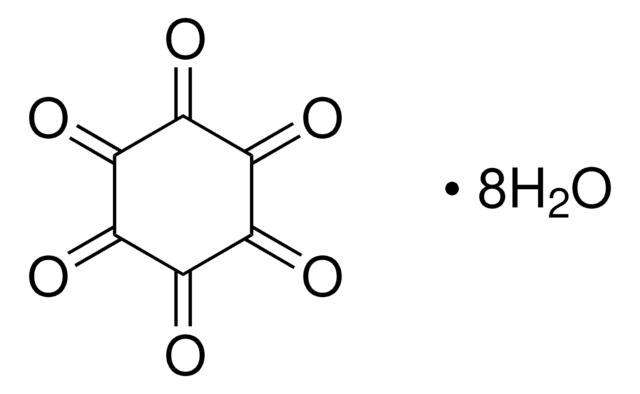230898
Antimony(III) oxide
powder, 5 μm, ReagentPlus®, 99%
Synonym(s):
Diantimony trioxide
Sign Into View Organizational & Contract Pricing
All Photos(3)
About This Item
Linear Formula:
Sb2O3
CAS Number:
Molecular Weight:
291.52
EC Number:
MDL number:
UNSPSC Code:
12352303
eCl@ss:
38080202
PubChem Substance ID:
NACRES:
NA.23
Recommended Products
product line
ReagentPlus®
Assay
99%
form
powder
particle size
5 μm
bp
1550 °C (lit.)
mp
655 °C (lit.)
SMILES string
O=[Sb]O[Sb]=O
InChI
1S/3O.2Sb
InChI key
ADCOVFLJGNWWNZ-UHFFFAOYSA-N
Looking for similar products? Visit Product Comparison Guide
Application
- Thermal Decomposition and Carbothermal Reduction: Examines the recycling and purification processes of Antimony(III) oxide from metal oxides, valuable for those interested in sustainable metallurgy (Karlsson et al., 2018).
- Oxidation of Antimony(III) in Soil by Manganese(IV) Oxide: Studies the interaction between manganese oxide and antimony(III) oxide in soils, providing insights into environmental chemistry and soil remediation (Fu et al., 2018).
- Adsorption of Antimony(V) onto Mn(II)-Enriched Surfaces: Focuses on how manganese oxide interacts with antimony(V), relevant for those studying adsorption processes and water treatment technologies (Liu et al., 2015).
- Kinetic Modeling of Antimony(III) Oxidation and Sorption in Soils: Provides a kinetic model of antimony(III) interactions with environmental matrices, useful for environmental scientists and chemists involved in pollution control (Cai et al., 2016).
Legal Information
ReagentPlus is a registered trademark of Merck KGaA, Darmstadt, Germany
Signal Word
Warning
Hazard Statements
Precautionary Statements
Hazard Classifications
Carc. 2
Storage Class Code
13 - Non Combustible Solids
WGK
WGK 1
Flash Point(F)
Not applicable
Flash Point(C)
Not applicable
Personal Protective Equipment
dust mask type N95 (US), Eyeshields, Gloves
Certificates of Analysis (COA)
Search for Certificates of Analysis (COA) by entering the products Lot/Batch Number. Lot and Batch Numbers can be found on a product’s label following the words ‘Lot’ or ‘Batch’.
Already Own This Product?
Find documentation for the products that you have recently purchased in the Document Library.
Customers Also Viewed
Nona Merry M Mitan et al.
Chemosphere, 72(7), 1073-1079 (2008-05-24)
The controlled pyrolysis of polyethylene/polypropylene/polystyrene mixed with brominated high-impact polystyrene containing decabromodiphenyl ether as a brominated flame-retardant with antimony trioxide as a synergist was performed. The effect of decabromodiphenyl ether and antimony trioxide on the formation of its congeners and
N Gurnani et al.
Biological trace element research, 37(2-3), 281-292 (1993-05-01)
Comparison of the clastogenic effects of antimony and bismuth used as trioxides, when administered orally by gavaging to laboratory bred male mice, showed that the former was more strongly clastogenic than the latter. Three doses of each chemical (400, 666.67
Koren K Mann et al.
Toxicology letters, 160(2), 158-170 (2005-08-23)
Very little is known concerning the toxicity of antimony, despite its commercial use as a flame retardant and medical use as a treatment for parasitic infections. Our previous studies show that antimony trioxide (Sb(2)O(3)) induces growth inhibition in patient-derived acute
David Kirkland et al.
Mutation research, 627(2), 119-128 (2006-12-19)
Antimony trioxide (Sb2O3, CAS 1309-64-4) is widely used as a flame retardant synergist in a number of household products, as a fining agent in glass manufacture, and as a catalyst in the manufacture of various types of polyester plastics. It
Koen Oorts et al.
Environmental science & technology, 42(12), 4378-4383 (2008-07-09)
Antimony trioxide (Sb2O3) is a widely used chemical that can be emitted to soil. The fate and toxicity of this poorly soluble compound in soil is insufficiently known. A silt-loam soil (pH 7.0, background 0.005 mmol Sb kg(-1)) was amended
Our team of scientists has experience in all areas of research including Life Science, Material Science, Chemical Synthesis, Chromatography, Analytical and many others.
Contact Technical Service











